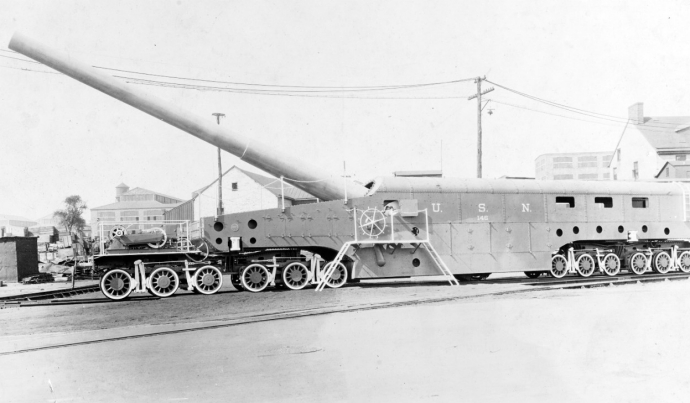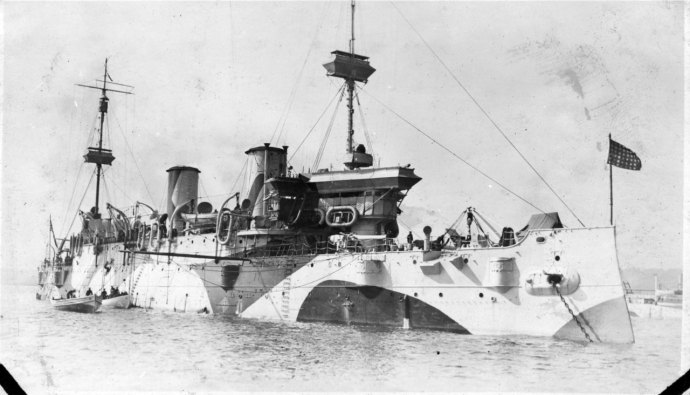Tactics and Technology

Naval 14"/50 railway gun on Mark I carriage at the Baldwin Locomotive Works, Philadelphia, Pennsylvania, after completion, 1918.
The types of operations required of naval forces during World War I — many of them involving new or evolving technologies and warfare tactics and techniques — brought with them many new challenges for the U.S. Navy. Among them were geographically far-flung logistics chains and lines of communication; deployment of naval personnel as railway artillerymen in France; new base installations requiring rapid construction; and the ever-present threat of German submarines to the essential transatlantic supply convoys. Each challenge was met, often in a unique way and, for the first time in U.S. history, with Allied nations and their navies as partners.
Logistics
Mine Warfare
- Attacking the U-Boat: The North Sea Mine Barrage. NHHC historian Dennis Conrad's essay covers the operational background and the technical aspects of laying the North Sea mine barrage.
- The Northern Mine Barrage and Other Mining Activities. NHHC historian Chris Martin provides an introduction on laying the mine barrage in the North Sea and a proposed barrage in the Adriatic.
- The Northern Barrage: Taking Up the Mines. NHHC historian Chris Martin provides an introduction on sweeping mines in the North Sea that had been laid to create the North Sea Mine Barrage.
Naval Railway Batteries in France
- Historical Summary of the U.S. Naval Railway Batteries. An essay on the history of the railway gun, by NHHC historian Gregory Bereiter, Ph.D.
- Operational History: U.S. Naval Railway Batteries in France. This monograph is the sixth of seven monographs in a series on the U.S. Navy in World War I. Read an introductory overview from NHHC historian Chris Martin and access the original text in the Online Reading Room.
Bureau of Engineering
History of the Bureau of Engineering During World War I. This history of the Bureau of Engineering is the fifth of seven monographs in a series on the U.S. Navy in World War I. Read an inductory overview from NHHC historian Jon Middaugh and access the original text in the Online Reading Room.
Antisubmarine Warfare and Convoying
Office of Naval Intelligence (ONI) documents
- ONI Compilation No. 14, Antisubmarine Information
- ONI, Submarine Silhouette Book No. 1
- ONI Publication No. 8, Notes on Anti-submarine Defenses
- ONI Publication No. 9, Antisubmarine Warfare
- ONI Publication No. 29, Remarks on Protection of a Convoy by Extended Patrols
- ONI Publication No. 30, Analysis of the Advantage of Speed and Changes of Course in Avoiding Attack by Submarine
- ONI Publication No. 32, German Submarines in Question and Answer
- ONI Publication No. 33, General Instructions for Sloops and Torpedo Craft Employed on Antisubmarine Duties
- ONI Publication No. 42, Antisubmarine Tactics
- ONI Publication No. 44, German Submarine Attacks
- ONI Publication No. 46, Kite Balloons in Escorts
Razzle Dazzle: The Art and Science of Ship Camouflage During World War I
Exhibit created by the National Museum of the U.S. Navy and the National Museum of the American Sailor. Download exhibit files using the links below:
- Introduction (PDF, 3.1 MB)
- Panels, small (PDF, 39 MB)
- Banners (PDF, 79.8 MB)
- Panels, full size
- Panel 1 (PDF, 3.5 MB)
- Panels 2-6: The First Dazzlers (PDF, 32.6 MB)
- Panels 7-12: The Unseen Menace (PDF, 29.5 MB)
- Panels 13-15: Deceiving the Eye (PDF, 29.8 MB)
- Panels 16-21: An Array of Schemes (PDF, 38.6 MB)
- Panels 22-27: The War of the Ways (PDF, 33.6 MB)
- Panel 28 (PDF, 3.4 MB)
- Panels 29-34: America Strikes Back (PDF, 28.7 MB)
- Panels 35-39: Assessing Razzle Dazzle (PDF, 33.5 MB)
- Panels 40-41 (PDF, 7.4 MB)

James J. Clerkin Sr. collection, photo S-023.01. USS Minneapolis (C-13) painted in dazzle camouflage. Photos in this collection were taken during the years 1917–1919. Download image.


